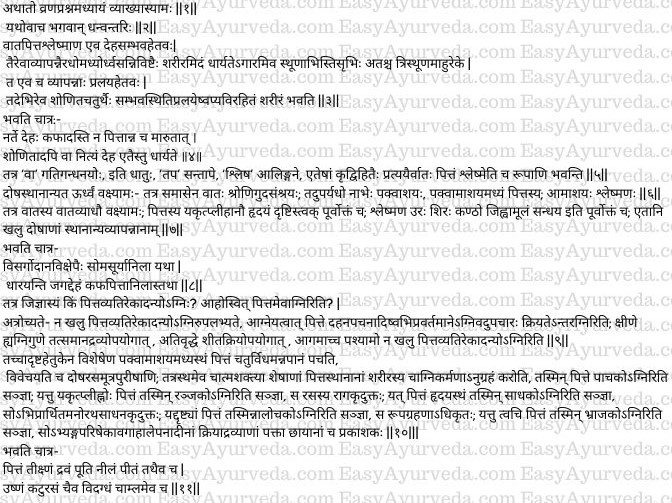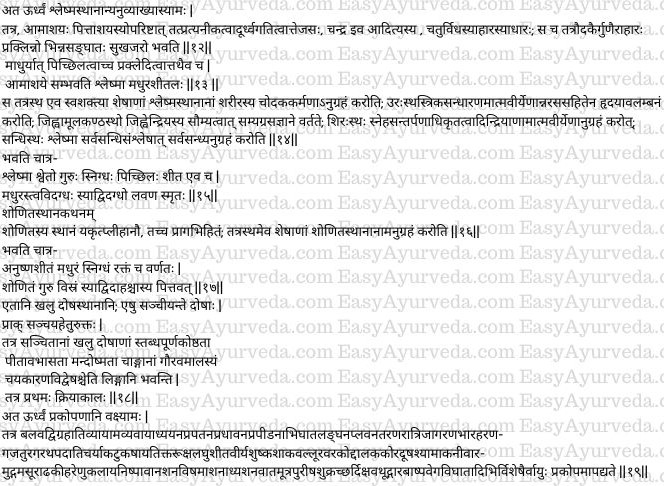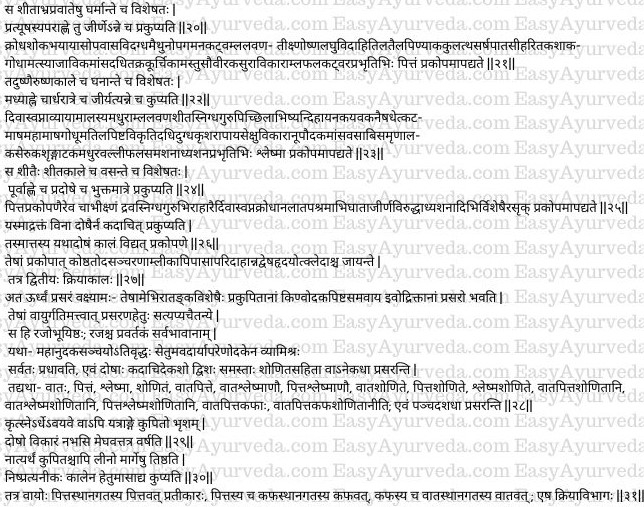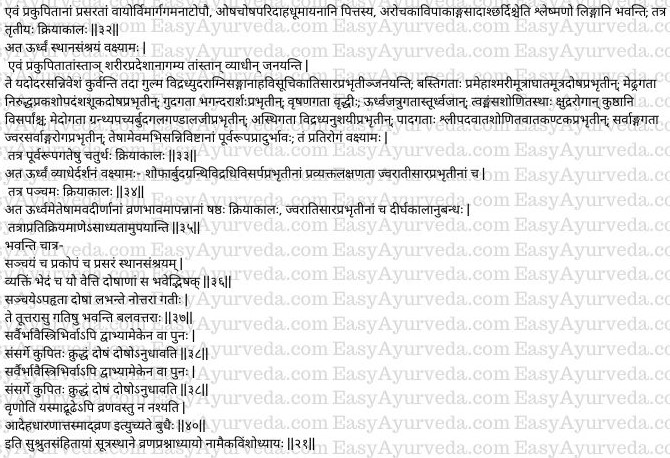
This article explains Sushruta Samhita Sutrasthana Chapter 21 “Vranaprashna Adhyaya”Question concerning wounds”.
Vranaprashna Adhyaya- Question concerning wounds
We will now expound the chapter by name vranaprashna- question, Information concerning wounds; as revealed by the venerable Dhanvantari.
Read – Lord Dhanwantari ‘The God of Ayurveda
Dosha Pramukhya

Importance of the doshas
Vata, Pitta and kapha only, are the causes for the origin of the body. By these (doshas) only, which are not abnormal and which are spread in the lower (vata), middle (pitta) and upper (kapha) parts (of the body) respectively, this body is supported just like the house being supported by three pillars. Therefore, the three doshas are called tristhunas i.e., ‘three pillars’ (of the body) by some authorities.
These (vata, pitta and kapha) only when abnormal become the causes for destruction (of the body). These three doshas along with Sonita (blood), the fourth (dosha) are present even during the origin, existence and destruction of the body.
The body never exists without kapha, pitta and vata
The body is never (never exists) without Kapha, Pitta, Maruta (Vata) and even Sonita (blood); the body is always supported by these;
Read – Tridosha Theory in Ayurveda
Nirukti
Etymology
Vata – From the verbal root ‘va’ meaning ‘movement’ and ‘causing hurt??’ and addition of prepositions, the term vata is derived.
Pitta – Similarly from the root ‘tap’ meaning ‘to create heat’ the term pitta is derived.
Kapha – From the root word ‘slish’, means embracing (adhering) the term “slesma’ is derived.
Dosha Sthana
Seats of the Doshas
Further, we will mention the seats of the Doshas (in the body). To state in brief, vata is localized in the sroni (pelvis) and Guda (rectum). Above this and below the Nabhi (umbilicus) is the Pakvasaya (large intestine). Pitta is localized between Pakvasaya (large intestine) and Amasaya (stomach and small intestine). Amasaya (stomach and small intestine, especially the stomach) is the seat of slesma (kapha).
Next, each of these (doshas) is divided into five (divisions). Those (five divisions) of vata we will describe in the chapter on Vatayadhi (ch.1 of Nidana Sthana).
Notes: Description of seats, divisions, and qualities of vata mentioned in chap. 1 of Nidana sthana are summarized here for ready reference. Vata is imperceptible but recognizable by its actions. It is dry, cold, light, rough (causes roughness), moves obliquely, predominant of rajo guna, of unthinkable capacity, leader / chief of the doshas, produces large number of diseases, quick in action, moves constantly and resides in Pakvasaya and Guda (large intestine and rectum).
The five divisions of vata are – Prana, Udana, Samana, Vyana and Apana.
Prana vata moves about (resides) in the mouth. It helps in swallowing, respiration (supports life), and produces hiccup, dyspnea and other diseases when it is deranged / imbalanced.
Udana Vata moves upwards (from the chest). Functions like speaking, singing etc. are caused by udana. When this vata is deranged, it produces diseases of organs above the level of one’s shoulder.
Samana Vata moves in the Amasaya and Pakvasaya (alimentary tract). It gets associated with digestive fire and takes part in cooking the food and separates its essence and wastes. When samana vata gets deranged or imbalanced it would cause abdominal tumors, sluggish digestion, diarrhea etc.
Vyana vata moves all through the body. It causes circulation of rasa, expulsion of sweat and blood and is responsible for all five kinds of movements. When vyana vata gets deranged it gives rise to diseases affecting the entire body.
Apana Vata resides in the Pakvasaya (colon, large intestine). It helps in elimination of faeces, urine, semen, fetus and menstrual blood at proper time and in proper quantity. When apana vata gets deranged it gives rise to diseases of the urinary bladder, rectum, vagina etc.
The seats of Pitta are – Yakrit (liver), Pliha (spleen) Hrdaya (heart), drsti (eye / pupil), Tvak (skin) and others mentioned earlier.
The seats of slesma (Kapha) are – Urah (chest), sirah (head), Kantha (throat), Jihvamula (root of the tongue), Sandhi (bony joints) and others mentioned earlier.
These are the seats of the doshas, when they are not abnormal (normal).
Read – Qualities Of Vata, Pitta and Kapha Dosha – Easy Explanation
Analogy to describe the functions of vata, pitta and kapha
Just as Soma (moon- water) Surya (sun-fire) and Anila (air) support the body of this world by functions like Visarga (releasing of strength) Adana (withdrawing strength) and Viksepa (initiating all actions) respectively, similarly Kapha, pitta and Anila (vata) support this human body (with respective functions).
Notes: – In the human body soma or water is represented by sleshma i.e., kapha, surya or fire is represented by pitta and air is represented by vata.
Functions of kapha include moistening, liquefying, lubricating, softening, combining things, providing resistance and endurance.
Functions of Pitta include digestion of food, body temperature, burning sensation, exhaustion, seeing, perspiration, destruction etc., intelligence and courage.
Functions of Vata include – causing movements of all kinds of all things, quickness and unsteadiness of actions, absorption, elimination, separating things, respiration, sensory perceptions, understanding pain, supporting and maintenance of life activities etc.
Read – Role Of Doshas As Tissues and Waste Products (Dhatu And Malaroopa Of Doshas)
Pitta- Vis-a- vis Agni
Now a point of debate; is there a separate agni (fire) apart from pitta or is pitta itself the agni? For this, we say, No Other Agni (fire) is ever found (in the body) apart from Pitta, because of presence of the properties of fire in Pitta, attending to burning, cooking (digesting) and such other functions it (pitta) is considered as Agni (fire) itself. When these functions like burning, cooking etc. are increased to abnormal levels in the body, as caused by increased pitta, it is treated on similar lines of treating the agni. This pitta is designated as antaragni (internal fire, digestive fire). Similarly, when pitta having the qualities / properties of agni (fire) undergoes decrease, its (pitta) increase is brought about by administering drugs which are having similar properties as those of agni i.e., having hot quality and potency (like chitraka, shunti, Pippali etc.). When pitta undergoes increase cold potency (quality) drugs are administered (which are having qualities opposite to those of agni).
Even in the scriptures (authoritative treatises of Ayurveda) we find that there is no (mention of) agni (fire) apart from pitta. (Therefore, there is no separate fire inside the body other than pitta, both are one and the same).
Read – Understand Pitta Dosha By Its Functions
Panca vidha- Pitta
Five division of Pitta
Pitta that is found localized in between (inside) Pakvasaya (large intestine, colon) and Amasaya (stomach and small intestine), by unseen causes (by nature/ naturally) i.e. by chance or due to the deeds done in the previous birth, cooks the four types of foods (digestion), separates the Dosas, Rasa (essence of food) Mutra (urine) and Purisa (faeces – waste products of food); remaining there itself it (in its own seat) helps the other sites of Pitta elsewhere in the body by bestowing properties of fire, this pitta is known as Pacakagni (pacaka pitta) digestive fire).
That pitta, found in the Yakrit (liver) and Pliha (spleen) is known as Ranjakagni (Ranjaka Pitta); it bestows red color to rasa Dhatu.
That Pitta, present in the hrudaya (heart) is known as Sadhakagni (Sadhaka pitta); it is responsible for fulfilling the desires of the mind.
That pitta present in the Drusti (eyes) is known as Alocagni (alocaka pitta); it is responsible for perception of forms (vision).
That pitta present in the tvak (skin) is known as Bhrajakagni (bharajaka Pitta), it is responsible for cooking (digestion and absorption) of substances used in the form of anointing, bathing, washing, immersing and poultices (application of paste) etc. and helps expression of shades (and colors) on the skin.
Read – Pitta Increase Symptoms – Pitta Vriddhi Lakshana
Qualities of Pitta
Pitta is penetrating (into the tissues), liquid, fetid (bad smelling), blue and yellow in color, hot in potency, pungent in taste (normally) and sour when improperly cooked.
Kapha

Kapha and its functions in the body
Next, we will describe the seats of slesma (Kapha). Amasaya (stomach and small intestine) is situated above Pittasaya (liver with gallbladder) because of opposite qualities and upward motion of Tejas (agni) just as the moon is to the sun; it (Amasaya) is the dwelling place of the four kinds of food. By its properties similar to that of water, the food becomes moistened, split into small particles and undergoes digestion easily. By the sweet taste, sliminess, and well moistened nature (of food in amasaya), Slesma (kapha) which is sweet in taste and cold, is produced in the Amasaya.
Read – Kapha Dosha – General introduction
Panca vidha kapha
Divisions of kapha
Remaining there (in its own seat) itself (in Amasaya), it (kapha) helps the other seats of slesma (Kapha) by its properties of water.
That Slesma (Kapha) residing in the uras (Chest) and trika (meeting place of head and the two arms (upper back) by its own properties and combined with those of the essence of food, supports the Hrdaya (heart).
That residing in the Jihvamula (base of the tongue) and Kantha (throat) by the moistness of the Jihvendriya (the organs of taste perception present in the tongue) helps the proper understanding of the taste.
That residing in the Siras (head), by its unctuousness and satiating (nourishing) qualities helps all the Indriyas (sense organs) to perform their functions properly.
That residing in all the Sandhis (bony joints) helps the joints by holding firmly (to cause easy movements).
Notes: – The name of the five divisions of kapha are Kledaka (in the Amasaya), Avalambaka (in the uras), Bodhaka (in the jihva), Tarpaka (in the Siras) and Slesaka (in the Sandhis).
Slesma guna
Properties of Kapha
Slesma (kapha) is white, heavy, unctuous, slimy, cold and sweet when not cooked (normal) but salty when improperly cooked.
Sonita (rakta) Sthana
Seats of blood
Seats of blood are Yakrt (liver) and Pliha (spleen), this has been said earlier (chap.14). Remaining there, it helps the other seats of blood.
Sonita (blood) is neither hot nor cold (but moderate), sweet in taste, unctuous, red in color, heavy, bad swelling and after improper cooking, it is like pitta (sour in taste and causing burning sensation).
Read – Is Blood, The Fourth Dosha? Controversy And Discussion
Dosa Sancaya
Mild accumulation of the Dosas- the first Kriyakakala
These (enumerated so far) are the seats of the Doshas. In these seats, the Dosas accumulate (after slight increase). The causes for accumulation have been described earlier (in chap.6).
The features (signs and symptoms) of the Doshas so accumulated are: –
1. Symptoms of accumulation (sancaya) of vata – stability (absence of movement), and fullness of the Kostha (alimentary tract) are the symptoms of vata sancaya.
2. Symptoms of accumulation (sancaya) of pitta – yellowish-white color of the body and mild increase of body temperature, are the symptoms of Pitta accumulation.
3. Signs of accumulation (sancaya) of kapha – feeling of heaviness of the body and laziness are the symptoms of kapha accumulation and hatredness towars the causes of accumulation (common to all the doshas). Is sited (are of kapha) and heatedness towards the causes of accumulation (this is common to all the dosas) are the symptoms.
This (sancaya) is the prathama Kriyakala (first stage of disease activity).
Read – Shat Kriya Kala – ‘Stage-Wise Disease Management’
Dosa Prakopa
Aggravation of the Dosas- Further we will describe the causes of Prakopa (great increase/ aggravation) of the Dosas
Etiological factors for vata aggravation – Vayu (vata) undergoes aggravation by
- fighting with stronger persons (or animals),
- too much of physical exercise,
- excessive indulgence in copulation and
- studying in excess;
- falling from a height,
- running,
- hurting / sprain,
- injury,
- jumping,
- hopping,
- swimming,
- keeping awake at night,
- carrying heavy load,
- riding (or running with) elephant, horses, chariots in excess,
- walking in excess,
- excessive indulgence in foods which are pungent, astringent and bitter in taste, dry (moisture free), light (quickly digesting) and cold in potency,
- excessive consumption of dried leafy vegetables and dried meat, varaka, Uddalaka, Koradusa, Syamaka, Nivara (these are pulses),
- excessive consumption of mudga, masura, adhaki, harenu, kalaya, nispava,
- fasting / starvation in excess,
- taking food at improper time etc
- overeating (more quantity of food often),
- suppressing the urges of flatus, urine, faeces, semen, vomiting, sneezing, belching and tears and such other causes

It (vata) also undergoes aggravation, especially at the time of cold (winter), accumulation of clouds in the sky, heavy breeze, at the end of summer (during rainy season), in the afternoons and evenings and after digestion of food.
Read – Relationship between Samprapti and Shat Kriya Kala
Pitta Prakopa karana
Causes for aggravation of Pitta
Etiological factors of pitta aggravation –
- anger,
- grief,
- fear,
- exertion,
- fasting,
- ingestion of foods which are spoiled or decomposed / causing burning inside the abdomen during digestion;
- more of copulation,
- excessive strolling / roaming,
- use of foods which are pungent, sour, and salt, penetrating, hot light for digestion, which cause heart- burn / corrosive – in excess,
- excessive consumption of oil of tila (sesame), Pinyaka (oil cake), Kulattha, Sarsapa, Atasi, haritaka Saka,
- excessive consumption of meat of iguana, fish, goat and sheep,
- excessive consumption of curd, buttermilk, cheese,
- excessive consumption of whey, fermented gruel, beer and its bye-products sour fruits, curds devoid of fat and such others
It (pitta) also undergoes aggravation especially during heat, hot season, after rainy season (during autumn), midday, midnight and during digestion of food.
Slesma prakopa karana
Causes for aggravation of Kapha
Etiological factors for kapha aggravation – Slesma (kapha) undergoes aggravation by –
- day sleep,
- absence of physical exercise,
- lassitude,
- excessive use of foods of sweet, sour and salt tastes, cold, unctuous (fatty), heavy (hard to digest), slimy, and those increasing the moisture inside the tissues;
- excessive consumption of Hayanaka, Yavaka, Naisadha, itkata (all are cereals),
- excessive consumption of Masa Mahamasa, Godhuma, tila pista vikriti (menu prepared from sesame paste)
- excessive consumption of curd, milk, rice boiled with mudga, milk pudding, products of sugarcane juice, meat and muscle fat of animals of marshy regions and of water,
- excessive consumption of bisa, Mrnala, Kaseruka, Srngataka, fruits of sweet taste and those of creepers;
- excessive intake of mixture of healthy and unhealthy foods,
- overeating and such others
It (pitta) also undergoes aggravation especially by cold, cold season (winter) and spring season, forenoon (morning), evening, and immediately after consuming food.
Read – Kapha Increase Symptoms – Kapha Vruddhi Lakshana
Rakta Prakopa Karana
Causes for aggravation of blood
Etiological factors for aggravation of blood – Asrk (blood) undergoes aggravation by the same causes which aggravates pitta, used frequently; also, by
- foods which are fluid, unctuous, and heavy (hard for digestion);
- sleeping at day,
- anger,
- exposure to fire and sunlight,
- exertion,
- injury,
- indigestion,
- partaking incompatible food etc
Since blood does not get aggravated without the association of other Doshas, the time of aggravation of Rakta is same as that of the Doshas.
Read – Understanding Blood Functions, Vitiation And Treatment As Per Ayurveda
Dosa prakopa
Aggravation, the second kriyakala
Aggravation of the Doshas produces –
- Kosthatoda, sancarana (mild or diffuse pain and movement inside the alimentary tract) – due to vata
- Amlika (sour belching), Pipasa (thirst), Paridaha (burning sensation all over the body) – due to pitta,
- Annadvesa (aversion to food), and hrdayotkaleda (nausea) – due to kapha,
This is the second Kriyakala (period of disease activity).
Dosa prasara
Spread of doshas – the third kriyakala:-
Next, we will describe Prasara. By the same exciting (aggravating) causes, the Doshas which are aggravated (increased) spread to other places just as the mixture of yeast, water and flour (of grains). Among these (tridoshas), vata is the cause of spreading, because vata ‘though devoid of sensation (inanimate) but having movement (due to rajo guna). Vata is predominant with rajo guna and the Rajo guna is the activator of all things. Just as great accumulation of water when further increased, flows over the dam and joins with water on the other side and runs all over the area, similarly the doshas which have accumulated and undergone aggravation would spread to other areas breaking all the barriers (of the places wherein they were meant to be) either individually, in combination of two, of all three or with sonata (blood) viz, Vata, Pitta, Slesma, Rakta, Vata-Pitta, Vata-slesma, Pitta-slesma Vata-sonita, Pitta-sonita, Slesma-sonita, Vata Pitta Sonita, Vata Kapha Sonita, Pitta Kapha Sonita, Vata Pitta Kapha, and Vata Pitta Kapha Sonita; in this manner the Dosas spread in fifteen types.
Notes: -Solution of flour of rice added with little yeast and kept undisturbed overnight undergoes fermentation and by the next morning it is seen spilling out of the vessel. Similarly, the doshas spread out of their own special seats and occupy the seats of other Doshas also, during this third stage.
The aggravated Dosha, thus spreading either to the entire body, half of it or any part of it, gives rise to diseases there just as clouds in the sky cause rain (at the place of their accumulation). If they (doshas) are not greatly aggravated (increased) then they remain in their paths adhering to it, and when not treated (eliminated) get aggravated again, in course of time, excited by (suitable) causes.
In such conditions,
- treatments for Vata, which has spread to the seats of pitta, should be those which mitigate pitta,
- treatments for pitta which has spread to the seats of kapha, should be those which mitigate kapha,
- treatments for kapha which has spread to the seats of Vata, should be those which mitigate vata,
These are the methods of treatments.
Read – Dosha Chaya, Kopa, Shamana – Accumulation, Aggravation, Auto-pacification
Prasara Kala laksana

Symptoms during this stage
Vata Prasara Symptoms – Symptoms of vata which has aggravated and spread to other places are –
- Vimargagamana (movement of things in wrong direction inside the alimentary tract) and
- Atopa (more of gurgling sound in the abdomen);
Pitta Prasara Symptoms – Symptoms of pitta which has aggravated and spread to other places are –
- Osa (feeling of burning sensation locally)
- Cosa (pain like sucking)
- Paridaha (burning sensation all over the body)
- Dhumamayana (feeling of hot fumes coming out from the stomach)
Kapha Prasara Symptoms – Symptoms of kapha which has aggravated and spread to other places are –
- Arocaka (loss of taste / appetite),
- Avipaka (indigestion)
- Angasada (debility of the body) and
- Chardi (vomiting)
This is the third Kriyakala (stage of disease activity).
Sthana Samsraya
Localisation – the fourth Kriyakala
Further, we will describe Sthana Samsraya – localization (of the Doshas). Doshas which are aggravated and spreading out, now become localized at certain places and produce diseases in such places.
- When they become localized in the abdomen, they produce tumors of the abdomen, abscess (internal), enlargement of the abdomen, sluggishness of digestive fire (activity), flatulence (enlargement of abdomen), visucika (gastro-enteritis), diarrhea and such other diseases.
- When localized in the urinary bladder, they produce diabetes, urinary calculus, retention of urine, other diseases of urine etc.
- When localized in the scrotum, they produce scrotal enlargement (hernia).
- When localized in the penis they produce phimosis, syphilis, sukadosha etc.
- When localized in the rectum, they produce fistula-in-ano, piles etc.
- When localized in the region above the collar bone they would produce diseases pertaining to the organs above the level of collar bone (diseases of the eyes, nose, ears, mouth, head etc.)
- When localized in the skin, muscles and blood they produce ksudra rogas (minor diseases), kushta (skin disorders), visarpa (herpes) etc.
- When localized in the fat tissue they produce cystic swelling, lymphadenitis, tumors, goiter etc.
- When localized in the bone they give rise to abscesses, anusayi (abscess on the foot) etc.
- When localized in the foot (legs) they produce filariasis, gout, sprains etc.
- When localized in the entire body they produce fever and diseases affecting the whole body.
By these Doshas only which have become localized, purvarupa (premonitory symptoms of diseases) get produced. We will describe these separately. This stage of appearance of premonitory symptoms is the fourth Kriyakala (stage of activity).
Read – Samprapti Vighatana in Vyadhi Kriya Kala – Breaking Pathogenesis
Vyakti Rupa
Manifestation of disease- the fifth Kriyakala
Next, we will describe the appearance of the diseases (with manifestation of characteristic features / signs and symptoms). It is the clear manifestation of the symptoms in diseases like swelling, malignant tumor, cysts / benign tumor, abscess, erysipelas and such other (external diseases) and also in fever, diarrhea and such others (internal diseases). This is the fifth Kriyakala (stage of activity).
Bheda
Chronicity the sixth Kriyakala
Next is the stage of burning / tearing of the swelling and formation of the wound and diseases such as fever, diarrhea etc becoming chronic. This is the sixth Kriyakala (stage of activity). If the diseases are not treated in this stage, they will become incurable.
He who understands the stages such as Sancaya (accumulation), prakopa (aggravation), Prasara (spreading), sthana samsraya (localization), Vyakti (manifestation) and bheda (chronicity) of the Doshas, can only be called the (real) physician.
Notes: – Sancaya and the other five stages of the disease process are known as roga samprapti (pathogenesis). During these stages the doshas got aggravated (increased) greatly, bringing about abnormalities in the Dhatus, Malas and Ojas. The number and severity of the symptoms and the curability or incurability of the diseases depend on the degree of such vitiation.
Selection of appropriate treatment and suitable drugs for each stage is the work of the physician. Hence great emphasis has been laid on a clear understanding of these six stages of disease evaluation. It is only Susruta who enumerates these ‘Sat Kriyakala” six stages and furnishes details of each. This stands testimony for his observation of the disease process.
Importance of treating the diseases in the early stages
Doshas, if eliminated during the Sancaya stage, do not undergo further stages; otherwise in the successive stages they become powerful.
Any Dosha which is aggravated either in all, any there, any two or even any one of its qualities, when combined with another Dosha, then the less aggravated Dosha will run after (follow, becomes secondary) to the greatly aggravated Dosha.
During such a combination, it is the powerful (greatly aggravated dosha) only that is to be treated, without interfering with the remaining; similarly, so in case of sannipata (combination of all the three doshas).
Read – Charaka Vrana Chikitsa – 25th Chapter – Wounds, Ulcers
Vrana nirukti
Definition of the wound
Varna is so called by the wise, since it covers (occupies the skin or the area of the body) and also because the vrana vastu (scar/ cicatrix formed later) does not get lost (disappear) even after healing and remains till the body survives.
Thus ends the Twenty first chapter by name Vranaprashna in Sutra sthana of Susruta Samhita.







